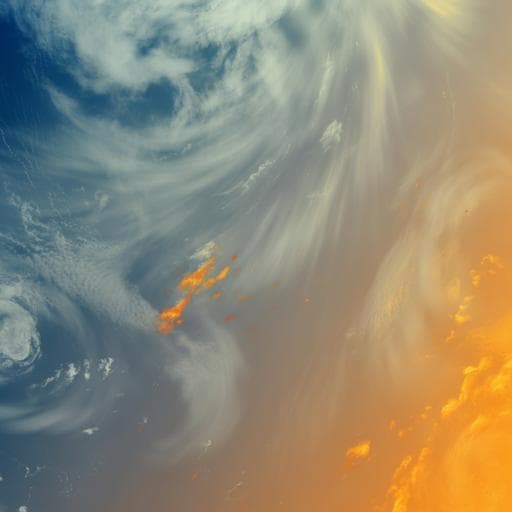
Earth Sciences
Aerosol effects during heat waves in summer 2022 and responses to emission change over China
M. Liang, Z. Han, et al.
This study, conducted by Mingjie Liang, Zhiwei Han, Jiawei Li, Yue Li, and Lin Liang, uncovers the intriguing role of aerosols during the heatwaves in eastern China. It reveals how aerosols not only cool the surface temperature but also affect PM2.5 levels, emphasizing the complex relationship between human activity and climate dynamics.
~3 min • Beginner • English
Introduction
Aerosols influence atmospheric environment and climate by scattering/absorbing radiation (direct effect), modifying cloud microphysics via acting as CCN/IN (indirect effects: albedo and lifetime), and altering meteorology (temperature, wind, humidity, precipitation) and thus chemistry (feedback effects). While aerosols generally cause net cooling and often reduce precipitation, absorbing species (e.g., black carbon) can warm and, under certain conditions, aerosols can invigorate convection. China’s rapid industrialization led to severe air pollution, notably the extreme January 2013 haze with PM₂.₅ > 1000 μg m⁻³ in events. National Clean Air Action Plans (2013–2017; 2018–2020 “Blue Sky”) and COVID-19 lockdowns (2020) substantially reduced anthropogenic emissions and PM levels. Summer 2022 saw unprecedented heat waves in China, linked to anomalous subtropical highs, GHG increases, and urbanization. However, the role of aerosols in radiation, meteorology, and chemistry during these heat waves, and how aerosol effects respond to recent emission changes, remained unknown. This study investigates the direct, indirect and total radiative effects of anthropogenic aerosols and their feedbacks on boundary layer meteorology and PM₂.₅ during August 2022 heat waves over eastern China, and quantifies their responses to emission changes over the past decade.
Literature Review
Prior research examined climate responses to China’s emission reductions from Clean Air Plans and COVID-19, including health and climate co-benefits, and projected aerosol effects under carbon neutrality scenarios. Studies reported positive radiative forcing and warming from reduced aerosol burdens (e.g., ~0.09–0.3 °C over earlier policy periods), often focusing on DRE or total effects with global models. Heat waves have increased in frequency and intensity; summer 2022 featured record extremes across China. Yet, previous work did not separate aerosol direct vs indirect effects during heat waves over China nor assess their differential sensitivity to recent emission changes. This study fills that gap by disentangling DRE and IRE and evaluating their feedbacks with a regional online-coupled model for August 2022 under multiple emission scenarios.
Methodology
Model: RIEMS-Chem, an online coupled regional climate–chemistry–aerosol model based on RIEMS. Includes land surface (BATS), PBL (MRF), Grell cumulus parameterization, modified NCAR CCM3 radiation with aerosol attenuation, gas-phase chemistry (updated Carbon-bond), photolysis (TUV), thermodynamics (ISORROPIA II), aerosol dry/wet deposition, heterogeneous reactions, SOA formation (two-product model), aerosol optical properties (Mie-based parameterization with OPAC), hygroscopic growth (κ scheme), activation to cloud droplets (Abdul-Razzak scheme), and warm cloud microphysics (Beheng autoconversion). Nine aerosol types represented; anthropogenic aerosols mix internally; dust/sea salt externally. Domain/resolution: Lambert projection centered at 110°E, 35°N; 60 km horizontal grid (89×75); 16 sigma vertical layers (seven in PBL). Study period: 20 July–31 August 2022 (first 12 days spin-up). Forcing/boundaries: NCEP FNL 1° meteorology; MOZART-4 chemical boundary conditions. Emissions: China anthropogenic emissions from MEIC 2013, 2019, 2020; 2022 emissions derived top-down using satellite retrievals and sensitivity simulations. Outside China anthropogenic emissions from MIX (2010) adjusted to 2022. Biomass burning (GFEDv4); biogenic VOCs (GEIA). 2022 top-down emissions: - NOx: derived using TROPOMI/OMI NO₂ columns and model sensitivity (β-scaling). - NMVOC: derived using satellite HCHO columns and sensitivity to 20% emission perturbations. - SO₂ and CO: scaled from 2020 MEIC using OMI products ratios (2022/2020). - PM₂.₅, BC, OC: scaled by SO₂ column ratio, assuming shared sectors. Experiments: - BASE: meteorology and emissions for Aug 2022. - EXP1: meteorology Aug 2022 + 2019 anthropogenic emissions. - EXP2: meteorology Aug 2022 + 2013 anthropogenic emissions. Radiative effect diagnostics within each experiment via paired radiation calls: - DRE: compare with vs without anthropogenic aerosols; aerosol–cloud microphysics perturbation off. - IRE: compare with vs without aerosols; aerosol direct radiative effect off; cloud microphysics perturbation on (first and second indirect effects). - TRE: compare with vs without aerosols with both DRE and cloud microphysics perturbations on. Feedbacks: Differences from a reference run (CASE0) without aerosol radiative feedbacks quantify impacts on meteorology (T2, WS10, PBLH, precipitation) and PM₂.₅. Evaluation: Compared modeled T2, WS10, RH2 (19 megacities) and PM₂.₅ (24 megacities), AOD (AERONET and MERRA-2), and precipitation (GPM IMERG). Correlations and biases indicate generally good agreement, with some regional biases (e.g., cloud/precipitation underprediction in parts of NE Asia; PM₂.₅ overprediction in some cities).
Key Findings
- August 2022 aerosol radiative effects over East China (EC): at TOA, DRE = −3.9 W m⁻², IRE = −2.4 W m⁻², TRE = −6.2 W m⁻² (BASE). At surface, DRE = −6.1 W m⁻², IRE = −2.2 W m⁻², TRE = −8.3 W m⁻². - Meteorological and air quality feedbacks (EC, BASE TRE): domain-period mean changes T2 −0.3 °C, PBLH −37 m, precipitation −4.5 mm, PM₂.₅ +0.4 μg m⁻³. - Regional contrasts (BASE): DRE strongest in BTH; IRE highest in SCQ and comparable to DRE at TOA there. TRE-induced cooling: BTH ~0.4 °C, YRD ~0.2 °C, SCQ ~0.3 °C; precipitation reduction largest in SCQ (~5.5 mm). - Heat wave subperiod (10–24 Aug): TRE effects smaller (e.g., warming sensitivity decreases as higher temperatures favor vertical diffusivity and aerosol evaporation): region-mean TRE-induced cooling of ~0.4 °C (BTH), 0.1 °C (YRD), 0.2 °C (SCQ) with smaller precip impacts than entire August. - Emission reduction impacts (2013→2022): • AOD and DRE decreased markedly from EXP2 (2013 emissions) to BASE (2022). Over EC, surface DRE decreased by 46%; TOA DRE decreased by 37%. IRE changed little (~−2.5 W m⁻² at TOA). • TRE at TOA reduced by 27% over EC (EXP2→BASE). Ratio of DRE:IRE at TOA over EC decreased from 2.5 (EXP2) to 1.6 (BASE); in SCQ (BASE), IRE slightly stronger than DRE. • Comparable DRE/TRE changes between EXP2→EXP1 (2013→2019 Clean Air Action) and EXP1→BASE (2019→2022 COVID-related), indicating similar magnitude impacts from both intervals. - Warming due to weakened TRE with emission reduction: • EC mean warming 0.14 °C for 2013–2022 (≈0.07 °C from 2013–2019 and 0.07 °C from 2019–2022), with mean precipitation increase 2.7 mm. • Maximum local warming >0.5 °C in BTH and Chongqing; associated increases in PBLH (>80 m), precipitation (>30 mm), and PM₂.₅ reductions (up to −14 μg m⁻³). • BTH shows largest regional warming (~0.4 °C) due to emission reduction; YRD smallest (~0.12 °C). - Mechanisms: DRE reductions dominate TRE weakening; IRE response is weak due to reduced sensitivity of cloud microphysics to CCN changes at already high CCN loadings. With lower aerosol levels (2022), IRE contribution to surface cooling becomes comparable to DRE in some regions (e.g., SCQ; EC averages DRE −0.17 °C vs IRE −0.13 °C for T2 impacts). - Air quality: TRE-induced cooling in 2022 increased PM₂.₅ by suppressing PBLH/turbulence; emission reductions (2013–2022) increased PBLH and decreased PM₂.₅ over many areas.
Discussion
The study addresses how anthropogenic aerosols modulated the August 2022 heat waves and how these effects evolved under decadal emission reductions. Aerosols produced net cooling and precipitation suppression over East China, increasing PM₂.₅ via reduced PBLH. Emission reductions from 2013 to 2022 diminished DRE substantially while leaving IRE nearly unchanged, thereby weakening total aerosol cooling (TRE) and causing a regional warming (mean 0.14 °C), most pronounced in BTH and Chongqing (>0.5 °C), potentially exacerbating heat waves. The weak IRE response indicates that in high-CCN regimes cloud microphysics saturate in sensitivity, elevating the relative importance of IRE as aerosols decline. Policy-wise, where clouds and aerosols are abundant (e.g., SCQ), IRE can offset some warming even as emissions are reduced, while in drier or less cloudy regions (e.g., BTH), DRE dominance implies more warming from further emission cuts. Overall, the findings clarify aerosol–radiation–cloud feedbacks during extreme heat and quantify how recent policy-driven emission changes translate into climatic and air-quality impacts.
Conclusion
This work quantifies the direct, indirect, and total radiative effects of anthropogenic aerosols during the August 2022 heat waves over China and their responses to decadal emission reductions using an online coupled regional model. Key contributions include: (1) separation of DRE and IRE impacts during a major heat-wave episode; (2) demonstration that emission reductions markedly weaken DRE while IRE remains relatively stable, elevating IRE’s relative importance in TRE and surface cooling; and (3) attribution of a mean warming of 0.14 °C (and increased precipitation) over East China during 2013–2022 to weakened TRE, with strongest warming in BTH/Chongqing. Future research should (i) improve 2022 emission estimates and constraints (especially primary aerosols) with enhanced satellite–in situ fusion; (ii) reduce cloud/precipitation biases and better represent aerosol–cloud interactions (including ice and convective processes); and (iii) extend to longer-term coupled ocean–atmosphere simulations to capture slow responses via SST feedbacks, and explore policy pathways optimizing health–climate co-benefits as aerosol burdens continue to decline.
Limitations
- 2022 anthropogenic emissions were derived via a top-down satellite-constrained method, introducing uncertainties from satellite retrieval biases and using column information to infer surface emissions and concentrations. - Model biases include underprediction of clouds/precipitation in parts of the domain (e.g., NE Asia), potentially underestimating IRE there, and city-specific PM₂.₅ biases (overprediction in some cities), stemming from meteorology, emissions, chemistry, boundaries, and coarse resolution. - Only fast climate responses were assessed (fixed SST) over a short period; slow responses via ocean coupling were not included and require longer-term coupled simulations. - Aerosol effects on ice nuclei and convective clouds were not represented, potentially omitting additional IRE pathways.
Related Publications
Explore these studies to deepen your understanding of the subject.







